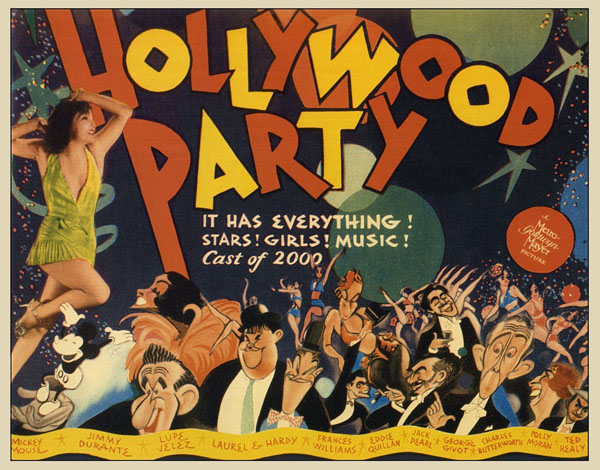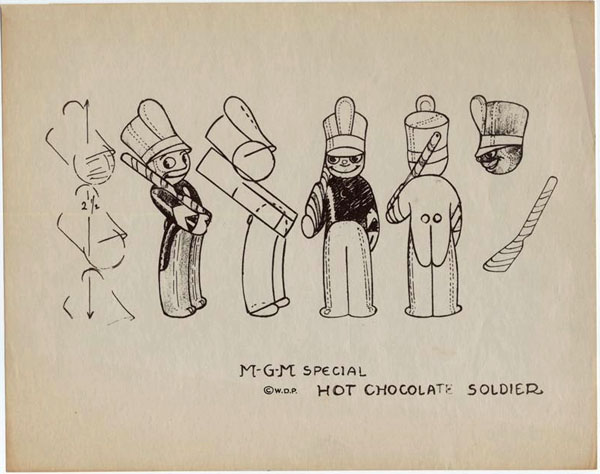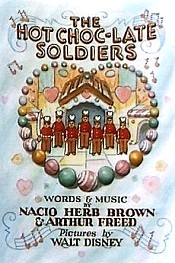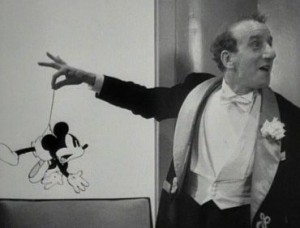
The republication of Walt Disney’s Silly Symphonies in a revised edition has been a really gratifying experience for me, partly because it has given Russell Merritt and me a chance to update our filmography. We simply know more now about these great cartoons than we did ten years ago, and it’s been a joy to revisit individual Silly Symphonies, clarifying, correcting, and expanding their production credits.
The same applies to a quasi-Symphony, Hot Chocolate Soldiers, produced in 1934 as an insert for the MGM feature Hollywood Party. Until recently, this little gem qualified as a “hidden” Disney classic like others that I’ve covered in this department.
To be sure, it was produced for theatrical showing in 1934—but after that initial release, its uncertain ownership status (stemming from complications in the Disney-MGM contract) caused it to be excised from television prints of the feature. Generations of viewers saw Hollywood Party, when they saw it at all, without benefit of the Disney scenes. Only in recent decades has the Disney material been reinserted in television and video editions for general audiences.
That’s a happy turn of events, for these charming sequences certainly don’t deserve to be consigned to obscurity. For those unfamiliar with the feature: Hollywood Party is an all-star MGM revue purporting to show a party at the palatial home of Jimmy Durante, attended by an array of celebrities (most of them MGM contract players). Partway through the party there’s a disturbance when some of the guests spot a mouse running around the floor. The mouse turns out to be Mickey, and he proceeds to introduce “Hot Choc’late Soldiers,” a new number by MGM songwriters Arthur Freed and Nacio Herb Brown. The song is illustrated by a Disney cartoon—“of the so-called ‘Silly Symphony’ type,” as the contract specified—depicting a war between chocolate and gingerbread soldiers. Most of Hollywood Party, including the Durante-Mickey Mouse combination scenes, is produced in black and white; Hot Chocolate Soldiers appears in full Technicolor.

HOT CHOCOLATE SOLDIERS
Backgrounds: Emil Flohri, Carlos Manriquez
Animation: Fred Moore (Mickey Mouse plays piano for introduction)
Leonard Sebring (chocolate soldiers and band start their march; chocolate general on
horseback leads troops [with Schmitt]; gingerbread soldiers fire rifles; chocolate soldiers fire melted marshmallows; gingerbread soldiers splattered by marshmallows; chocolate soldiers and band march home with gingerbread prisoners; chocolate soldiers march and melt in closing scenes)
Cy Young (Perspective scenes of marching and returning chocolate soldiers; girls wave to soldiers; sun shines on returning chocolate soldiers)
Louie Schmitt (goodbye kiss; chocolate general on horseback leads troops [with
Sebring]; cavalry mounted on Easter chicks; ambulances [with Williams]; gingerbread spy sees approaching army; chocolate general smeared by cream puff; gingerbread general on battlements, orders gates opened and soldiers leave posts)

Ben Sharpsteen crew:
Leonard Sebring (chocolate soldiers march over bridge)
George Drake (ammunition wagons; chocolate soldiers climbing candy cane are hit by eclairs)
Dick Williams (gingerbread buglers; chocolate soldiers in lollypop field, including general’s fall)
Roy Williams (gingerbread soldiers run from tents)
Roy Williams (ambulances [with Schmitt]; chocolate soldiers fire cannons; chocolate
soldiers batter gate with candy cane)
Jack Kinney (cannons; gingerbread soldiers take positions on battlements; gingerbread
soldiers catapult cream puffs from forks)
Frank Oreb (Easter egg tanks)
Milt Schaffer (gingerbread spy sounds alarm at fort)
Bob Kuwahara (chocolate soldiers hook candy cane over battlements)
Ugo D’Orsi (gingerbread soldiers with eclair cannon; chocolate soldiers fall in eclair goo
at bottom of candy cane)
Joe D’Igalo (candy dove wheeled up to and into gate; chocolate soldiers spring out from
interior)
Animation of this little charmer took place during the summer of 1933, nearly a year before release of the finished feature. But while MGM endlessly rewrote and reworked the main body of the feature, Disney likewise continued to fuss with details of Hot Chocolate Soldiers. Cy Young’s scene of the beaming sun was added after the rest of the sequence had been completed, and subjected to several tests (to perfect the effect of double-exposed waves of heat) before the retake of the ending was delivered to MGM in January 1934. And while early drafts had called for introductory and ending scenes, establishing that all this action took place in the window of a candy store, the finished sequence eschews this setting and plunges directly into the action.
 I think it’s interesting that the transitional scene, bridging the black-and-white and Technicolor sections, survives only in partial form. It would be nice to see the full composite image, but in a way it’s equally fascinating to see only the color element, as we do here—with the song sheet presumably matted into the b&w shot, and with the animated mask to keep the color from “bleeding” through Mickey’s left hand as he plays piano. It’s also interesting to note some of the personnel assigned to this project.
I think it’s interesting that the transitional scene, bridging the black-and-white and Technicolor sections, survives only in partial form. It would be nice to see the full composite image, but in a way it’s equally fascinating to see only the color element, as we do here—with the song sheet presumably matted into the b&w shot, and with the animated mask to keep the color from “bleeding” through Mickey’s left hand as he plays piano. It’s also interesting to note some of the personnel assigned to this project.
Ben Sharpsteen, after supervising junior animators on this and other pictures, was promoted to director soon afterward (and one of his first directorial efforts was The Cookie Carnival!). Other artists like Roy Williams and Jack Kinney, who would likewise go on to other departments, are also seen here as animators. So is George Drake, whose principal occupation was training new artists, but who occasionally animated a scene or two himself.
We did include an entry on this picture in Walt Disney’s Silly Symphonies, so I don’t want to repeat myself too much here—it seems like cheating. (The animation credits in the book are accurate but condensed for space limitations; the more detailed credits above come directly from my notes.) But it’s worth noting that the Mickey Mouse scenes, in which Mickey banters with Jimmy Durante and plays the piano, were produced in the autumn of 1933, well after Hot Chocolate Soldiers had been substantially completed.
 That’s because Hot Chocolate Soldiers is essentially self-contained, while Mickey’s scenes, being integrated with the main body of Hollywood Party, were subject to the constant revisions of MGM’s writers. In the Disney studio’s own cartoons, Mickey was usually a mouse of few words; his cartoons tended to be long on sight gags, short on dialogue. For several months in 1933, however, MGM’s writing staff disregarded this fact as they rewrote the Mickey-Durante scenes over and over again. Their scripts proposed long, unwieldy dialogue passages for Mickey, passages which may well have been vetoed by Walt himself. Another idea called for Mickey to perform imitations of Greta Garbo and other MGM stars, using soundtracks supplied by the studio. This idea, too, was discarded (apart from Mickey’s quick, teasing imitation of Durante himself) in favor of the simpler action we see in the finished sequence. Production papers reveal that some, and perhaps all, of Mickey’s scenes were animated by Fred Moore. Moore’s uncommon facility as an animator had been noted by this time, and 1933 represented a kind of breakthrough year for him at the studio—particularly as a Mickey specialist—so it’s no surprise to see a plum assignment like this one handed to him.
That’s because Hot Chocolate Soldiers is essentially self-contained, while Mickey’s scenes, being integrated with the main body of Hollywood Party, were subject to the constant revisions of MGM’s writers. In the Disney studio’s own cartoons, Mickey was usually a mouse of few words; his cartoons tended to be long on sight gags, short on dialogue. For several months in 1933, however, MGM’s writing staff disregarded this fact as they rewrote the Mickey-Durante scenes over and over again. Their scripts proposed long, unwieldy dialogue passages for Mickey, passages which may well have been vetoed by Walt himself. Another idea called for Mickey to perform imitations of Greta Garbo and other MGM stars, using soundtracks supplied by the studio. This idea, too, was discarded (apart from Mickey’s quick, teasing imitation of Durante himself) in favor of the simpler action we see in the finished sequence. Production papers reveal that some, and perhaps all, of Mickey’s scenes were animated by Fred Moore. Moore’s uncommon facility as an animator had been noted by this time, and 1933 represented a kind of breakthrough year for him at the studio—particularly as a Mickey specialist—so it’s no surprise to see a plum assignment like this one handed to him.
All in all, the Hollywood Party sequences represent, at the very least, a charming sidelight on Disney history. Their decades of obscurity were undeserved, and I hope my fellow enthusiasts are as delighted as I am to see them back on public view again.
NEXT WEEK: Disney’s “Servants’ Entrance” Sequence


 J.B. Kaufman is an author and film historian who has published and lectured extensively on Disney animation, American silent film history, and related topics. He is coauthor, with David Gerstein, of the Taschen book “Walt Disney’s Mickey Mouse: The Ultimate History,” and of a forthcoming companion volume on Donald Duck. His other books include “The Fairest One of All,” “South of the Border with Disney,” “The Making of Walt Disney’s ‘Fun and Fancy Free’,” and two collaborations with Russell Merritt: “Walt Disney’s Silly Symphonies” and the award-winning “Walt in Wonderland: The Silent Films of Walt Disney.”
J.B. Kaufman is an author and film historian who has published and lectured extensively on Disney animation, American silent film history, and related topics. He is coauthor, with David Gerstein, of the Taschen book “Walt Disney’s Mickey Mouse: The Ultimate History,” and of a forthcoming companion volume on Donald Duck. His other books include “The Fairest One of All,” “South of the Border with Disney,” “The Making of Walt Disney’s ‘Fun and Fancy Free’,” and two collaborations with Russell Merritt: “Walt Disney’s Silly Symphonies” and the award-winning “Walt in Wonderland: The Silent Films of Walt Disney.”







































Would you do some of Disney’s sponsored films for your next “The Other Disney Cartoons”? Thank you.
Such as the propaganda animated films Disney did for Canada for their “4 for $5” War Bond campaign during World War II?
Thank *you*. And yes, I’d like to! If I get a chance to research some of them in depth, I’ll surely do that at the first opportunity.
Oh, indeed, I’m delighted that “HOLLYWOOD PARTY” is back in print. I don’t know whether this has ever been shown again in theaters, but it is an interesting film, and the DVD (from Warner Archive of course) features extras, like rehearsal takes of the little numbers that appear throughout the film, including the “HOT CHOC-LATE SOLDIERS” tune; well worth owning for those who don’t know about this. I was alerted to it years and years ago by a friend of mine who had the then little-known movie on actual film stock.
Since it was created for MGM, I thought that Hugh Harman and Rudy Ising had a hand in the “HOT CHOC-LATE SOLDIERS” sequence, but this might have been done just as Hugh and Rudy were transitioning to MGM, so this comes before the first HAPPY HARMONIES title was created. Sometimes I wonder what Disney classics would have been if MGM was the studio where the cartoons were created. Considering the badgets that were tossed at the HAPPY HARMONIES, it might have been an amazing fit with even more spectacle than Disney mustered for his finished early shorts and features.
It’s great to have it, but it really is a train wreck with too much dead space between the gems (mainly some Laurel and Hardy bits and Durante occasionally wringing laughs from the script). The opening number — a sharp Rodgers & Hart song by sexy chorus girls — gets your hopes up, then you’re left to wonder how much money was obviously spent while the film never quite makes it to entertainingly bad.
I’ve seen other poster art that really plays up the image of Mickey Mouse (and Laurel and Hardy), implying a much bigger presence. That must have irritated Disney as well.
I’m finally grateful that we have a credited animator for the Mickey Mouse scenes (and of course it would be Fred Moore).
In a documentary about the MGM studio Stanley Donen recounts the time he and Gene Kelly approached Walt Disney to have Mickey Mouse dance with Kelly in Anchors Aweigh. According to Donen Disney said, “Mickey Mouse will never be in an MGM picture”. Maybe he meant never again.
Maybe so!
The strike soured Walt on many of his business dealings. By the mid-40’s, MGM had built up an animation studio comprised of many former Disney artists, and Tom and Jerry had already begun their Academy Award winning streak which threatened to eclipse the Disney product. Walt had probably already established a policy of no more loan-outs of his characters to other studios. The Disney characters were kept separate for decades. I believe they didn’t mingle with characters from other studios until 1988’s “Who Framed Roger Rabbit.”
According to what I have read, which may or may not be pure legend, Walt was the one who said, “You have a mouse of your own–why not use him?” or words to that effect. Anyway, it’s fun to speculate that the use of Jerry the Mouse in the “Anchors Aweigh” animated segment may have been Walt’s suggestion!
Congratulations on the newly revised Silly Symphonies volume! A few years ago, I spent over a year trying to locate a copy of the original (and paid a hefty price for it) when I learned of its existence.
“Servant’s Entrance” always interested me, so I look forward to your next post. I hope to see other rarities like the Disney animation for “My Lips Betray” or “Around the World in 80 minutes” with Douglas Fairbanks in your column in the future!
Thank you, Scott!
I’ve always wondered about the missing levels in the transitional shots. That they were on different film elements makes sense, I guess. A wonderful movie with a great all-star cast. Charles Butterworth is the best!